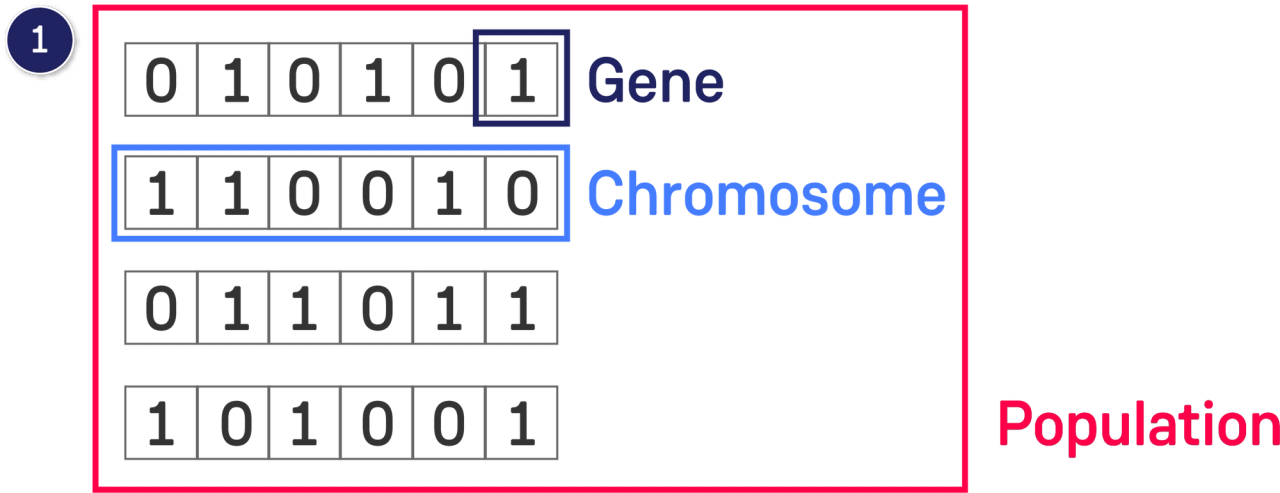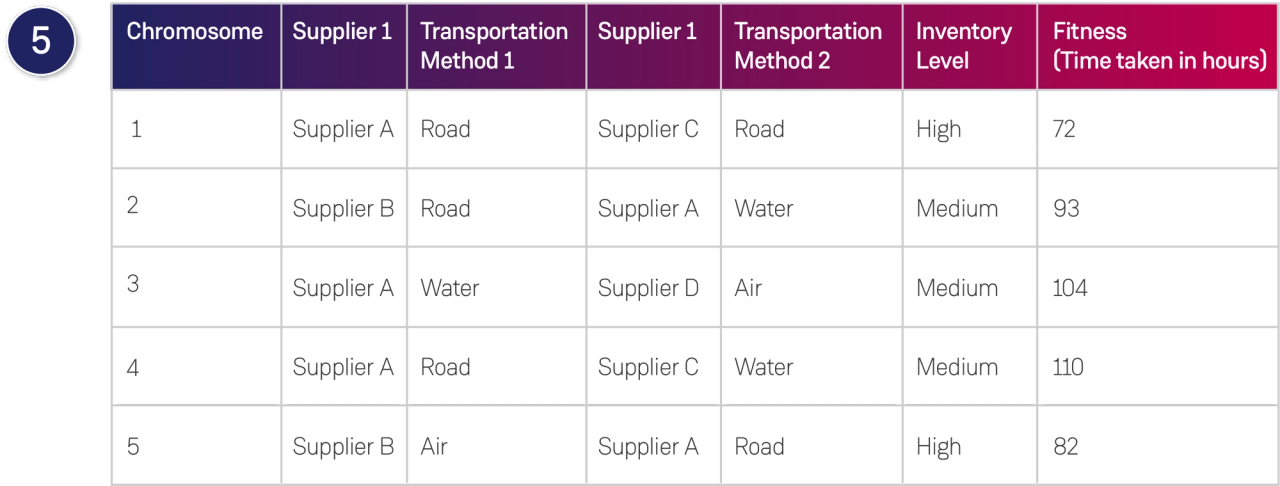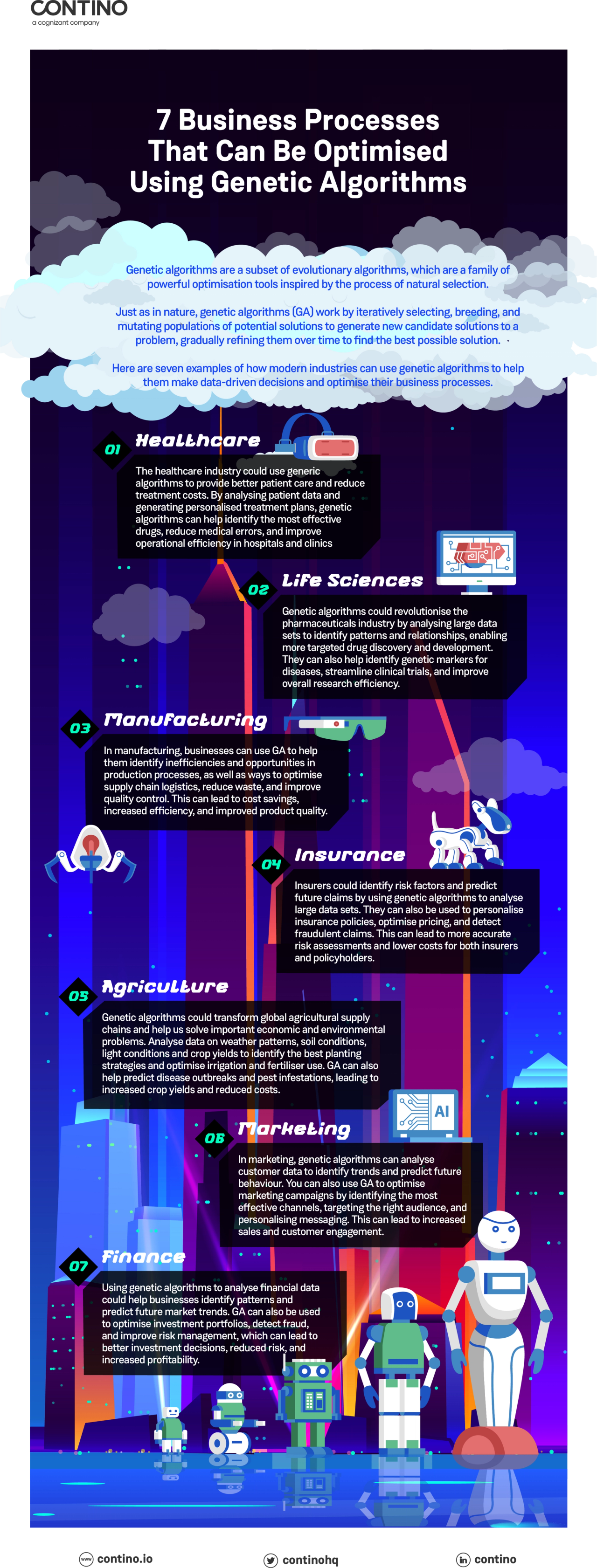Optimising Business Processes: The Darwinian Way to Better Decision Making
A hot topic that isn’t going anywhere soon, AI & ML is on everyone’s lips and according to IDC’s 2022 Business Intelligence and Analytics Survey, 75% of organisations will demand new decision making features currently unavailable in their enterprise business software.
By 2025, at least 90% of new enterprise application releases will include embedded AI functionality, a trend largely driven by market conditions, evolving technologies and our appetite for innovation and cutting-edge solutions. But for all the possibilities and the latest trending technologies, how can businesses actually get real value from AI & ML solutions? One answer might lie in evolution.
Charles Darwin's theory of natural selection revolutionised our understanding of how living organisms adapt and evolve to their environment. Inspired by this concept, genetic algorithms have emerged as a powerful tool for businesses seeking a data-driven approach to solving complex problems and improving performance.
As an AI approach, genetic algorithms (GA) can help us tackle pressing global issues in many areas including industrial optimisation, supply chain optimisation, financial modelling and agri-tech optimisation. In digital transformation, GAs have a vital role to play in helping businesses analyse large data sets and factor in multiple variables to better understand priorities, stress-test options and future-proof solutions.
In this article we’ll explain how genetic algorithms can be used to analyse potentially millions of variables against your business goals, weighing every option for its benefit and identifying the best solution to give you a competitive edge. We’ll use a supply chain example throughout to demonstrate how genetic algorithms work, and we’ll illustrate the range of possibilities through several industry use cases. You’ll also learn how Cognizant and MIT used a genetic algorithm to speed up plant growth.
What Are Genetic Algorithms?
Genetic algorithms are a subset of evolutionary algorithms, which are a family of powerful optimisation tools inspired by the process of natural selection.
Just as in nature, genetic algorithms work by iteratively selecting, breeding, and mutating populations of potential solutions to generate new candidate solutions to a problem, gradually refining them over time to find the best possible solution.
Genetic algorithms are not limited by human biases or cognitive limitations; instead they use objective fitness functions to evaluate the best solution.
Solutions are typically represented as strings of genetic information, called "chromosomes," that encode potential solutions to the problem.
By mimicking the principles of biological evolution, genetic algorithms offer a flexible and efficient approach to solving complex business problems, such as supply chain optimisation, scheduling, or financial modelling. By harnessing the power of genetic algorithms, businesses can streamline their operations, reduce costs, and gain a competitive advantage in their market.
Search Space
The search space in genetic algorithms refers to the set of all possible solutions to a problem. The goal of the genetic algorithm is to search through the entire search space to find the best possible solution. This is accomplished through the iterative process of selecting the most promising solutions, recombining and mutating them to generate new solutions, and evaluating the fitness of each solution to determine its quality.
For example, if a business is trying to optimise its supply chain, the search space could include different combinations of suppliers, transportation methods and inventory levels. The search space can be very large and complex, making it difficult to find the optimal solution using traditional methods. Genetic algorithms excel at searching through large and complex search spaces to find optimal solutions.
Fitness
In a genetic algorithm, "fitness" refers to the measure of how well a potential solution (represented by a chromosome) solves the problem being addressed. Fitness is used to evaluate the quality of each solution. It guides the selection and breeding of potential solutions (chromosomes) by determining the best-performing individuals for reproduction.
--------------
(The Science Bit...)
The fitness function is a domain-specific mathematical function that takes a solution as input and outputs a fitness score. The score is typically a numerical value that indicates how well the solution solves the problem. The fitness function will impact the effectiveness of the algorithm, so great care should be taken when designing it.
Selection methods prioritise individuals with higher fitness scores to ensure their genes are passed onto the next generation. Genetic operators such as crossover and mutation create new offspring chromosomes that combine the genes of their parents. The offspring chromosomes are evaluated for fitness, and the best-performing individuals are selected for the next generation. Through successive iterations, the algorithm converges on a population of potential solutions with high fitness scores, leading to faster convergence and better results.
----------------
For example, in the case of supply chain optimisation, fitness might be defined as the time it takes to deliver products to customers and derived from a mathematical function of the permutation of supplier, transportation methods, and inventory levels represented in a chromosome. Better fitness is indicated by shorter delivery times.
The following equation shows how fitness for our supply chain example is a function of the suppliers, transportation methods, and inventory levels used.
To bring our supply chain example to life, imagine your supply chain involves two legs. You can use a choice of three suppliers (A, B and C) and each has three transport methods (Road, Air, Water) and there are three inventory levels (Low, Medium and High). In this problem there are approximately 250 solutions in the search space, some of which will offer an optimal solution with the shortest delivery time. We start to solve our optimisation problem by first creating three random supplier, transport, inventory combinations and then calculate their fitness as shown in the table below.
The table shows three different chromosome representations of the variables used when calculating delivery time in a supply chain optimisation problem. Fitness is derived using a mathematical function based on the five genes. Chromosome 1 has the best fitness of 72 hours. Different chromosomes (with different permutations of the genes) may yield a better fitness.
Operators
Genetic algorithms use two main operators to generate new solutions: crossover and mutation.
Crossover
Crossover involves combining two or more parent solutions to produce a new offspring solution. This process mimics the natural process of reproduction where genetic material from two parents combines to create a new offspring. In genetic algorithms, the crossover operator randomly selects a crossover point in each parent solution and combines them to create a new solution.
In our supply chain example Chromosomes 1 and 2 have the best fitness and are selected as parents for breeding.
Offspring are created by exchanging the genes of the parents after the crossover point.
The new offspring, Chromosomes 4 and 5 are added to the population.
Mutation
Mutation occurs to maintain diversity within the population and involves randomly changing one or more genes in a solution. This process mimics the natural process of genetic mutation that occurs over time. In genetic algorithms, the mutation operator randomly selects one or more genes in a solution and changes them to a new value.
In our example, Gene 2 in Chromosome 5 is randomly selected for mutation.
Once the breeding, crossover and mutation steps are complete, the fitness of the new offspring is calculated and the next two fittest chromosomes from the population are selected for breeding and so on and so forth. In our example this would be Chromosomes 1 and 5.
Termination
The algorithm terminates if the population has converged (i.e. does not produce offspring significantly different from the previous generation). The optimal solution found by the algorithm in the search space of possible solutions is the chromosome with the best fitness. In our example, the shortest delivery time.
While our supply chain example above is fairly trivial and perhaps a traditional brute force optimisation method could be used, one can easily imagine a more complex solution with a vast search space where brute force would no longer be viable. For example if there were just 20 input parameters (genes) with possible values of one or zero, the search space would contain over one million solutions!
Now that you have a basic understanding of genetic algorithms let's look at some industry applications.
Examples of Business Processes that can be Optimised using Genetic Algorithms
Download the infographic here
Healthcare
The healthcare industry could use generic algorithms to provide better patient care and reduce treatment costs. By analysing patient data and generating personalised treatment plans, genetic algorithms can help identify the most effective drugs, reduce medical errors, and improve operational efficiency in hospitals and clinics.
Life Sciences
Genetic algorithms could revolutionise the pharmaceuticals industry by analysing large data sets to identify patterns and relationships, enabling more targeted drug discovery and development. They can also help identify genetic markers for diseases, streamline clinical trials, and improve overall research efficiency.
Manufacturing
In manufacturing, businesses can use GA to help them identify inefficiencies and opportunities in production processes, as well as ways to optimise supply chain logistics, reduce waste, and improve quality control. This can lead to cost savings, increased efficiency, and improved product quality.
Insurance
Insurers could identify risk factors and predict future claims by using genetic algorithms to analyse large data sets. They can also be used to personalise insurance policies, optimise pricing, and detect fraudulent claims. This can lead to more accurate risk assessments and lower costs for both insurers and policyholders.
Agriculture
Genetic algorithms could transform global agricultural supply chains and help us solve important economic and environmental problems. Analyse data on weather patterns, soil conditions, light conditions and crop yields to identify the best planting strategies and optimise irrigation and fertiliser use. GA can also help predict disease outbreaks and pest infestations, leading to increased crop yields and reduced costs.
Marketing
In marketing, genetic algorithms can analyse customer data to identify trends and predict future behaviour. You can also use GA to optimise marketing campaigns by identifying the most effective channels, targeting the right audience, and personalising messaging. This can lead to increased sales and customer engagement.
Finance
Using genetic algorithms to analyse financial data could help businesses identify patterns and predict future market trends. GA can also be used to optimise investment portfolios, detect fraud, and improve risk management, which can lead to better investment decisions, reduced risk, and increased profitability.
Growing basil with GA
Let’s finish up by looking at a video that shows how evolutionary algorithms help find solutions to problems that human decision-making can miss, by modelling the real world and uncovering the most effective, efficient, lowest cost and/or highest revenue generating outcomes. In this example a genetic algorithm was used to find the optimal growing conditions for basil—the answer was surprisingly simple.
Summary
Genetic algorithms are a powerful tool that you can use to make data-driven decisions to optimise your business. By mimicking the natural process of evolution, genetic algorithms can efficiently search through large and complex search spaces to find optimal solutions without bias or cognitive limitations, while eliminating suboptimal solutions. Genetic algorithms make it possible to identify the best approaches to create designs, build processes and develop products.
Whether your objective is to lower costs, boost margins, cut time to market or improve competitiveness, contact Contino or reach out to Rich Wadsworth on LinkedIn to find out how we can help.
Download our infographic on the 7 Business Processes That Can Be Optimised Using Genetic Algorithms














